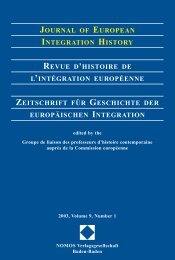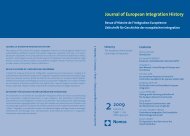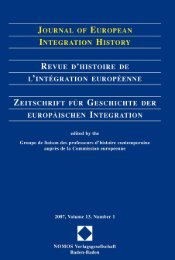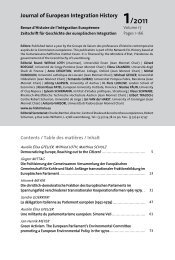journal of european integration history revue d'histoire de l ...
journal of european integration history revue d'histoire de l ...
journal of european integration history revue d'histoire de l ...
Create successful ePaper yourself
Turn your PDF publications into a flip-book with our unique Google optimized e-Paper software.
Choosing the Periphery 91<br />
had traditionally fished insi<strong>de</strong> the twelve-mile coastal zone would be exclu<strong>de</strong>d after<br />
a transition period. Only because the 1964 London convention on European fisheries,<br />
which accommodated Norwegian interests by codifying in international law a<br />
fishing zone <strong>of</strong> twelve nautical miles, allowed these foreign fishermen to maintain<br />
their traditional fishing in the zone between six and twelve miles, did Norway not<br />
ratify the London convention. Fears that the Norwegian position would hurt fish export,<br />
including the favourable EFTA-clause on frozen fish to Great Britain, counted<br />
less than maintaining the preferential fishing regulations. The Norwegian negotiator<br />
was instructed not even to accept specific parts <strong>of</strong> Norwegian waters being covered<br />
by the London convention. 40 Norway's expansive and rigid fishing-limit policy<br />
bears witness to the strong position <strong>of</strong> the fisheries sector in the core <strong>of</strong> Norway's<br />
political economy.<br />
III. The Community Seen as a Challenge<br />
Never had the Norwegian authorities been so afraid <strong>of</strong> the tariff union as in<br />
1957-58. In the autumn <strong>of</strong> 1957, Tra<strong>de</strong> minister Skaug reported on the threat to<br />
Norwegian export interests if France and Italy were to succeed in forcing the establishment<br />
<strong>of</strong> a “high-tariff union”, which would <strong>de</strong>velop into “a policy <strong>of</strong> self-sufficiency<br />
<strong>of</strong> quite consi<strong>de</strong>rable scope”. 41 This fear eventually applied to the tariff rates<br />
that were not <strong>de</strong>termined by the Treaty <strong>of</strong> Rome, but which in accordance with List<br />
G were to be negotiated at a later stage. The government estimated that sixty-two<br />
per cent <strong>of</strong> Norwegian export revenues in 1956 came from export commodities<br />
un<strong>de</strong>r this category.<br />
The grounds for the fear <strong>of</strong> the tariff union may be illustrated by the Norwegian<br />
aluminium plan. Due to the lack <strong>of</strong> capital, the government had slowed down the<br />
pace <strong>of</strong> industrialisation in the long-term programme for the 1954-57 period. But it<br />
subsequently geared up the pace <strong>of</strong> <strong>de</strong>velopment for 1958-61. In 1938, Norway had<br />
produced 29,000 tonnes <strong>of</strong> aluminium. Production had risen to 93,000 tonnes in<br />
1956. Plans now called for extending the capacity to 250,000-300,000 tonnes by<br />
the end <strong>of</strong> the 1960s, which would make Norway the <strong>de</strong>ci<strong>de</strong>dly largest producer in<br />
Europe. 42 Needless to say, the Government was uncertain as to whether the EEC<br />
would create difficulties for these plans, and the opportunity for reaching long-term<br />
agreements was thus a primary concern during two meetings in 1958 between Gus-<br />
40. Stortingsarkivet, Oslo [The Parliamentary Archives] (henceforth, SA), Stortingets utvi<strong>de</strong><strong>de</strong> utenriks-og<br />
konstitusjonskomite [The Parliament's Exten<strong>de</strong>d Foreign Policy and Constitutional Committee]<br />
(henceforth, SUUKK), Minutes <strong>of</strong> 4 March 1964, p. 12. The SUUKK was an informal<br />
committee in which the government informed the parliament on <strong>de</strong>licate matters, thus helping to<br />
establish the necessary parliamentary consensus on foreign policy.<br />
41. SA, SUUKK, Minutes <strong>of</strong> 14 July 1957, p.13.<br />
42. E. BROFOSS, De økonomiske integrasjonsplanene i Europa [The Economic Integration Plans in<br />
Europe], Oslo, 1958, p.18.

















